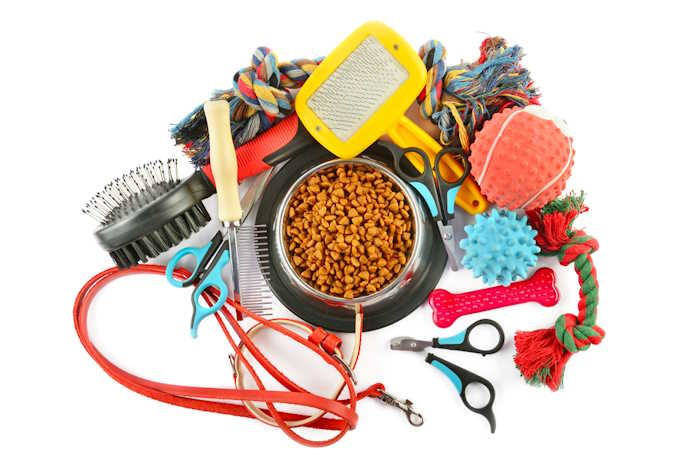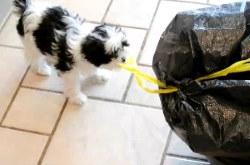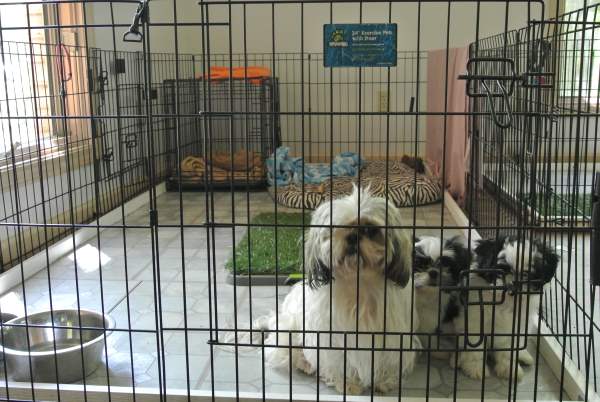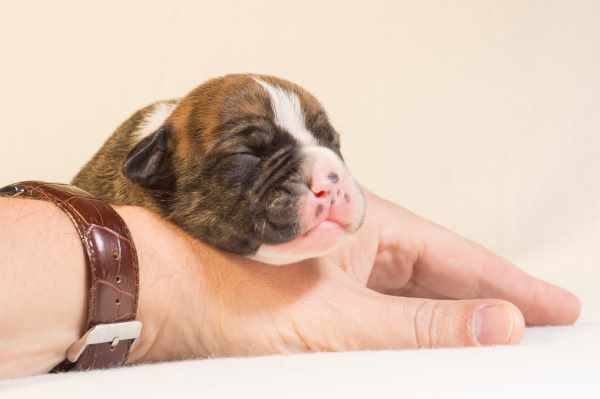Bringing Home a New Puppy
Comprehensive Guide for Small Dog Lovers
By Janice Jones |Last Updated 04-28-2024
Bringing home a new puppy is an exciting event for most people, especially those families with children. The much anticipated event is finally here, and it’s time to welcome the new ball of fur into your home. But Wait!
Wait?
Read these pointers first hopefully before the big day.
No worries if you were not able to read before puppy’s arrival, there are still things you might find helpful.
What Your Breeder Can do to Help with the Transition
Sometimes it is not possible, but sometimes all you have to do is ask. What can you ask for?
- A mother scented blanket
- Food samples
- Crate training
- Water bottle training
- Pad Training
- Other???
Before bringing home a new puppy, let’s look at some ways you can prepare – yourself, your family, your home, and even the puppy (assuming the breeder agrees).
After years of bringing puppies into the world and also bringing home puppies myself, in my opinion, these are the eight essential tasks you must do ahead of time, if not shortly after puppy comes home.
We’ll cover each at length. You can read through the page or use these links to hop around.
Links to Selected Sections on this Page
Table of Contents
Puppy Proof Your Home and Your Yard
Prepare a place where puppy will stay
Alert all who are also
anxiously awaiting the new puppy
Arrange for a Vet Visit
(Shop for a Vet if you don’t already have
one)
Pick a Name Before Bringing Home a New Puppy
Some people prefer to pick the puppy’s name after they have him home and can observe his behaviors.
Others want to choose a name long before the puppy leaves the breeder’s home.
Either way is fine, but there is an advantage to picking out a name early on. If the breeder agrees, let him/her know what name you will use and ask the breeder to start using that name.
By the time the puppy arrives at your home, they will already know their name. Here is more information about naming a puppy.
Shop for Supplies
 It is advisable to purchase at least a few supplies before bringing home a new puppy.
It is advisable to purchase at least a few supplies before bringing home a new puppy.Few people miss this step because it is the most fun to do.
Whether this is your first puppy or your 21st, a new puppy needs some basic supplies all of his own.
If you have children, they will want to be in on this shopping spree.
Talk to your kids ahead of time and make a list. You really don’t want to go overboard because many of the items you purchase today will need to be replaced as the puppy grows.
It is fun to go into a large pet store and browse all the isles or visit a small specialty shop to look for something unique before bringing home a new puppy.
Others prefer to take their new puppy shopping with them. Either way works, but I don't recommend taking the dog shopping on your way home from the breeders. That may be just a bit too much excitement and stress for a young puppy.
As you shop, though, you are likely to realize that the best prices for dog items will be online.
Be realistic about your budget and what you pup really needs. Splurging on a $50 (USD) collar for a tiny puppy may not be practical if you will need to replace it in a month.
On the other hand, some items you buy will last a long time, such as a crate or puppy stroller. Shop for those larger items carefully and purchase the best quality you can afford.
What are the items that puppies will need from Day One?
These are the basics. You may want to check out our other page on supplies needed for puppies.
- Food and Treats (Find out from the breeder what the puppy eats.
- Dishes (water and food) or a water bottle if the breeder uses these
- Crate and or bed
- Small enclosed pen or baby gate to keep puppy confined.
- Small brush and comb appropriate for your breed’s hair. Ask the breeder which ones to purchase if you are not sure.
- ID Tags with your name, your puppy’s name and your phone number
- Collar, harness, leash
- Clean up supplies (yard rakes and shovels, poop bags, puppy pads, enzymatic cleaner
Puppy Proof Your Home and Yard
 Puppy Proof Your Home before Bringing Home a New Puppy
Puppy Proof Your Home before Bringing Home a New PuppyThat sounds like a daunting task doesn’t it?
But don’t worry about the entire house or apartment just yet because your new friend is not likely to be allowed free access to all areas.
Chose the room or rooms that you think your puppy will eat, sleep and play and concentrate on those areas first.
Puppies like to chew, tear and pee.
Anything that they can chew on, they will until they are taught otherwise.
Be sure any electrical wires are out of reach. Antique tables or chairs or expensive furniture that you don’t want little teeth marks on should be moved out of the way.
Puppies also seem to masters of finding small objects (children's toys, etc.) left in corners, so a thorough cleaning before bringing home a new puppy is recommended
Wall trim is another favorite, and that is not something you can move.
To preserve your home, purchase a bottle of Grannick's Bitter Apple for Dogs Spray Bottle,Chewing is a normal behavior, and you can eliminate much of the destruction by buying chew toys.
Visit our puppy proofing page for
more ideas.
Trash cans can be a great toy for a curious puppy. Small, lightweight cans can be easily tipped spilling out a feast fit for a king (or tiny puppy).
Either place an open trash can outside the permitted area or purchase one with a tightly fitted lid.
The best news for people bringing home a new puppy that is small is they are not likely to be able to knock over small tables, steal food and other items from little tables, or swish their tail so feverously to knock over a small child.
(We’ll save those behaviors for larger breed dogs.)
Puppy Proof Outdoors Before Bringing a New Puppy Home?
People rarely think about the outdoors when preparing for a puppy.
Look around the area where your puppy will be permitted and be sure there is nothing there that could cause harm.
Poisonous plants can make a young puppy sick in a very short time. Avoid fertilizers and yard treatments before you bring your dog home.
If your yard is fenced in, will the size of the fence keep the puppy in?
Some breeds are so small that they fit quite comfortable between the slats in a fence or gate.
Do you have a garage where you keep potentially hazardous items? The easiest way to assure safety is to prevent the puppy from entering the garage.
Luckily most small breed dogs can be carried from the home to your car preventing them the opportunity to taste antifreeze or paint thinner.
Pools, Ponds, Streams? Any type of water can be a problem and puppies have been known to drown in even a small amount of water.
If you haven’t had time to do this one step before arrival, supervise the puppy carefully, both inside and out.
Before Bringing Home a New Puppy, Prepare a Place for Your New Puppy
 This is a very easy puppy enclosure to make using a base such as plywood or wall paneling, vinyl floor tiles, x-pen and trim.
This is a very easy puppy enclosure to make using a base such as plywood or wall paneling, vinyl floor tiles, x-pen and trim.Puppies feel most secure when they have a
place they can call their own.
It doesn’t
need to be big if you are dealing with a small breed puppy, but there should be enough room to fit a crate,
bed, water and food dishes, and a place to eliminate.
Many small breed dogs enjoy a little blanket to snuggle with, and others enjoy a stuffed toy. Either ask your breeder to provide a "Mama scented" blanket, or send one for her to use and return to use when you bring your puppy home.
Both give the puppy the feel of snuggling
with litter-mates. If the puppy is
left alone for awhile in his area, provide a variety of toys and chews.
You can prepare this one area in the corner of a room using a puppy play pen or X-pen.
Another option is to choose a small room that the puppy will stay, usually with a floor surface that is easy to clean.
Some people also convert a small closet for a dog room and make it cozy and comfortable. Whatever you decide based on the layout of your home will be okay as long as you follow these simple suggestions:
- Must be secure so the puppy can’t jump or climb over or can wiggle through the bars.
- Must be comfortable
- Never used as a “time out” or as a punishment.
- Cleaned regularly
Alert All who are also Anxiously Awaiting the New Puppy
You’ve chosen a puppy, picked out a name, purchased some supplies and fixed up your home.
No doubt you’ve been talking about this puppy with neighbors, co-workers, and friends every time you are given a chance.
Soon everyone knows about the new puppy. Some may even give you a puppy shower.
It is a good idea to let everyone know the day the puppy is to arrive. You will do this as a courtesy to them and the puppy.
Tell your friends that they can come see the puppy later in the week or even in a week or two.
Why?
Puppies need to get to know their family first. These are the people the puppy will build the strongest bond.
Don’t overwhelm a small puppy with too many visitors. There will be time for that later as you begin to socialize your new puppy.
Arrange for a Vet Visit Before Bringing Home a New Puppy

One important question you should ask the breeder involves the purchase contract.
Is there one?
What is the health guarantee? (There are many more issues to ask a breeder, and you can read about them here.)
Many purchase agreements stipulate that new owners arrange for a vet visit within a short amount of time, typically 48-96 hours after purchase for the contract to remain in effect.
Appointments with favorite vets can be scheduled a week or more out, so it is important to call ahead of time so you don’t miss your window of opportunity.
Even if there is no clause about getting the puppy vet checked, it is still a wise thing to do.
Puppies can get sick easily, carry worms, and will need regular vaccinations.
Your vet is a good source of information and will explain vaccination schedules and proper puppy care.
Be prepared to take a fecal sample when you go to your first appointment, so they can check for internal parasites. Ask if your puppy should take a heartworm preventative or flea treatment/preventative.
Sign-Up Puppy Training Classes
While this is not necessary before the puppy arrives, it is always advisable to begin socialization and training from day one.
Puppy classes can teach you how to train them and at the same time provide some valuable socialization skills for your new puppy.
Most metropolitan areas have many different types of dog training facilities, but they may not always be easy to find.
Look for classes given by pet stores such as your big box stores, your local shelter, or even your veterinarian.
Doggie Day Care facilities also often advertise training classes and larger boarding facilities do as well.
If you know, you will be going beyond basic puppy kindergarten and obedience, consider contacting a kennel club in your area.
Many kennel clubs are associated with the AKC and offer all breed training. Others are breed specific. Your breeder may be able to direct you to an appropriate class.
Training classes may be harder to find in rural areas. Even if you can’t find a good class, you should not neglect your puppy’s training. The internet is full of information on dog training, or you could purchase a good book about dog training.
Plan a Schedule Before Bringing Home a New Puppy
Any parent can
tell you that kids that are on a structured schedule do better overall. Dogs Too!
Scheduling doesn’t need to be rigid, but a puppy will respond better to eating, sleeping, playing, and learning if he can predict what will come next.
Schedules are different for each family, so it would be difficult to print a one-size-fits-all schedule.
Here are a couple of guidelines to help you plan your puppy’s day.
- Potty training proceeds faster if there is a
set time in the morning to take the puppy out.
This may mean no more sleeping in on the weekends.
- Puppies
generally need to eliminate about 15-20 minutes after a meal or large drink of
water.
- Puppies
take 1-2 hour naps throughout the day.
The rest of the time is devoted to active
play, short training sessions, meals, and elimination.
- Tiny
puppies may not be able to sleep throughout the night. Most puppy buyers assume they may need to get
up at least once during the wee hours of the morning to take the puppy
out.
- As the puppy’s bladder grows, the length of time between eliminations lengthens too. At first, they will eliminate every 1 ½ to 2 hours.
Other Pets at Home?
If you have other pets at home, bringing home, a puppy may be a little more challenging.
Your other dog, cat or pet may not be as excited to see a new family member and they are likely going to let you know it.
Plan ahead how you will make these introductions and respond to the older pet and new puppy.
Plan these meetings on a neutral site so the older dog does not feel as if he must guard his own territory.
This advice can be tricky because you don’t want to choose a dog park but a quiet park with few distractions might work.
Please visit my page on Getting a Second Dog for more information. Or
Alternately, if you have a friend or neighbor willing to lend you their yard, take them up on offer.
Unfamiliar territory puts both the new and the old dog on equal standing.
Don’t get worried if both ignore each other. (That has been my experience).
Just keep it friendly and upbeat. Give both dogs a treat and a drink of water and then head to your home.
Expect a little jealousy and some minor fights during the coming weeks.
Watch body language. The older dog may give a quick, sharp bark.
If the puppy lies down and rolls over on his back and the older dog walks away, all is good. If the older dog continues to attack when the puppy has assumed this position of submission, jump in to protect the puppy.
If you are introducing a puppy to a much older dog, it may be the older dog you will need to protect from the rambunctiousness we call youth.
The most important thing that you can do during the coming weeks is to supervise carefully.
Don’t get lured into a false sense of security if all goes well during the first day.
We call that the “Honeymoon” period when everyone is on their best behavior.
Bringing Home A New Puppy - The BIG DAY!
The big day has finally arrived, and you are likely to be excited and maybe even a little nervous.
Chances are good the puppy is feeling the same way, so take his needs into consideration. What Puppies Need is a quick read that you might want to check out?
Will you be going to pick up your new dog?
Many people do have to travel either by car or plane to get a new puppy. Plan for the trip, even if it is a 30-minute car ride.
Very young puppies don’t have the experience of a moving car that we take for granted.
Pack a puppy bag to take with you. Even if you are picking up your puppy from an airport, these items are recommended. What should you bring?
Expect the worst and be pleasantly surprised when you don’t need any or all of the items below.
- Paper towels and
small bottle of cleaner
- Puppy Pads
- Bowls for water and
food (if a long trip is anticipated); Bottled water
- Long Ride? If the puppy doesn't
eat the regular food, I recommend
a high caloric supplement to prevent hypoglycemia)
- Poop bags and a
small bag to collect trash
- Wipes for cleaning
up a messy puppy (You don’t have to purchase the ones specifically for dogs as
baby wipes will be okay. Alternately, you could place a couple small washcloths
in a plastic bag and use some of the bottled drinking water for cleanup)
- Crate or another type of car carrier lined with puppy pads
and a small blanket. A car seat is ideal for older dogs, but they don’t work well
when the puppy is young.
- Toys and Chews (Don’t be surprised if they don’t play much during the car ride)
Bringing Home a New Puppy...
The Adventure Continues...
May we suggest you check out these other pages with useful information about puppies.
How Much Sleep Does Your Dog or Puppy Need?
About Janice (author and voice behind this site)
Janice Jones has lived with dogs and cats for most of her life and worked as a veterinary technician for over a decade. She has also been a small-breed dog breeder and rescue advocate and holds academic training in psychology, biology, nursing, and mental health counseling. Her work focuses on helping dog owners make informed, responsible decisions rooted in experience, education, and compassion.
When not writing, reading, or researching dog-related topics, she likes to spend time with her six Shih Tzu dogs, her husband, and her family, as well as knitting and crocheting. She is also the voice behind Miracle Shih Tzu and Smart-Knit-Crocheting
Does This Article Deserve Your Thumbs Up?
We always appreciate your support and encouragement. Your thumbs up means so much to us. Please like this article.
If you find this page or any page on Small Dog Place Helpful, or useful in anyway, I'd love it if you would click the small heart found on the bottom right of each page.
You can also share or bookmark this page -- just click on the:

Free Monthly Newsletter
Sign Up for Our Free Newsletter and get our Free Gift to You.
my E-book, The Top 10 Mistakes People Make When Choosing a Dog (and how to avoid them)



